Policy Designing
VerifiedAdded on 2022/10/04
|8
|1582
|440
AI Summary
This article discusses three policy options for underserved populations in the United States, including healthcare coverage for non-communicable diseases, genetic counseling for couples, and insurance for daily wage workers. The intended outcomes, decision criteria, and recommendations for each policy are also presented.
Contribute Materials
Your contribution can guide someone’s learning journey. Share your
documents today.

Running head: POLICY DESIGNING
Policy Designing
Name of the Student
Name of the University
Author Note
Policy Designing
Name of the Student
Name of the University
Author Note
Secure Best Marks with AI Grader
Need help grading? Try our AI Grader for instant feedback on your assignments.
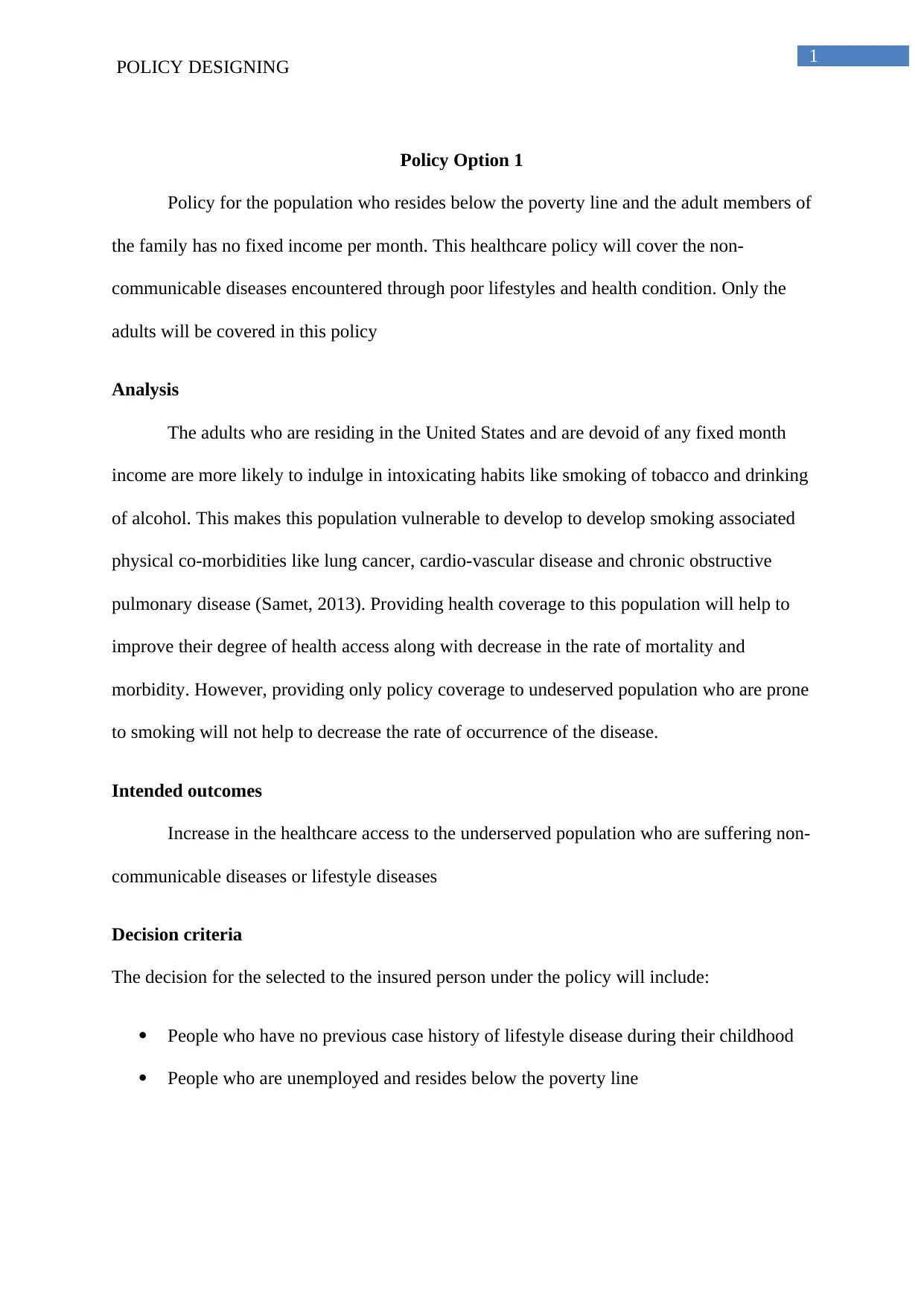
1
POLICY DESIGNING
Policy Option 1
Policy for the population who resides below the poverty line and the adult members of
the family has no fixed income per month. This healthcare policy will cover the non-
communicable diseases encountered through poor lifestyles and health condition. Only the
adults will be covered in this policy
Analysis
The adults who are residing in the United States and are devoid of any fixed month
income are more likely to indulge in intoxicating habits like smoking of tobacco and drinking
of alcohol. This makes this population vulnerable to develop to develop smoking associated
physical co-morbidities like lung cancer, cardio-vascular disease and chronic obstructive
pulmonary disease (Samet, 2013). Providing health coverage to this population will help to
improve their degree of health access along with decrease in the rate of mortality and
morbidity. However, providing only policy coverage to undeserved population who are prone
to smoking will not help to decrease the rate of occurrence of the disease.
Intended outcomes
Increase in the healthcare access to the underserved population who are suffering non-
communicable diseases or lifestyle diseases
Decision criteria
The decision for the selected to the insured person under the policy will include:
People who have no previous case history of lifestyle disease during their childhood
People who are unemployed and resides below the poverty line
POLICY DESIGNING
Policy Option 1
Policy for the population who resides below the poverty line and the adult members of
the family has no fixed income per month. This healthcare policy will cover the non-
communicable diseases encountered through poor lifestyles and health condition. Only the
adults will be covered in this policy
Analysis
The adults who are residing in the United States and are devoid of any fixed month
income are more likely to indulge in intoxicating habits like smoking of tobacco and drinking
of alcohol. This makes this population vulnerable to develop to develop smoking associated
physical co-morbidities like lung cancer, cardio-vascular disease and chronic obstructive
pulmonary disease (Samet, 2013). Providing health coverage to this population will help to
improve their degree of health access along with decrease in the rate of mortality and
morbidity. However, providing only policy coverage to undeserved population who are prone
to smoking will not help to decrease the rate of occurrence of the disease.
Intended outcomes
Increase in the healthcare access to the underserved population who are suffering non-
communicable diseases or lifestyle diseases
Decision criteria
The decision for the selected to the insured person under the policy will include:
People who have no previous case history of lifestyle disease during their childhood
People who are unemployed and resides below the poverty line
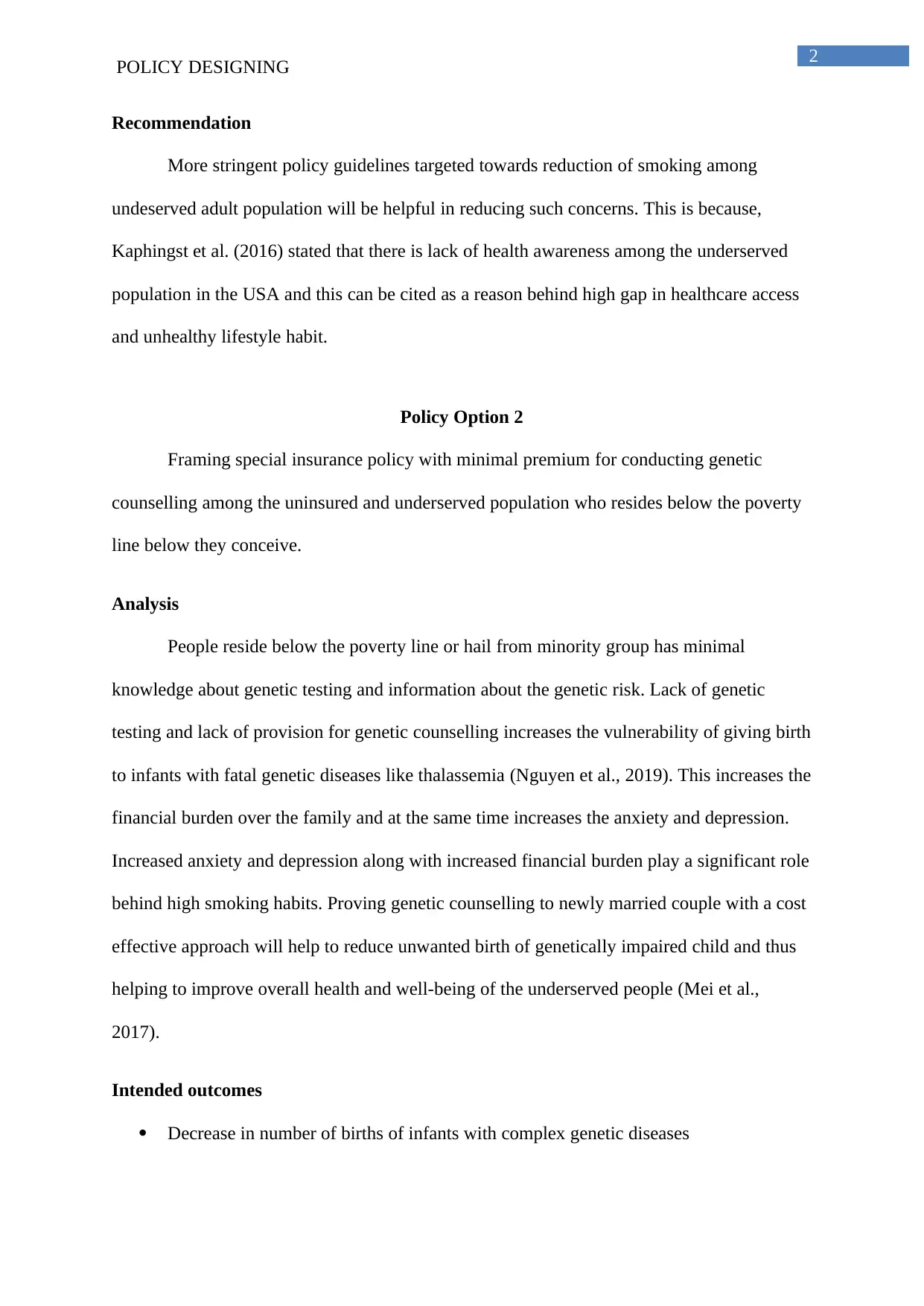
2
POLICY DESIGNING
Recommendation
More stringent policy guidelines targeted towards reduction of smoking among
undeserved adult population will be helpful in reducing such concerns. This is because,
Kaphingst et al. (2016) stated that there is lack of health awareness among the underserved
population in the USA and this can be cited as a reason behind high gap in healthcare access
and unhealthy lifestyle habit.
Policy Option 2
Framing special insurance policy with minimal premium for conducting genetic
counselling among the uninsured and underserved population who resides below the poverty
line below they conceive.
Analysis
People reside below the poverty line or hail from minority group has minimal
knowledge about genetic testing and information about the genetic risk. Lack of genetic
testing and lack of provision for genetic counselling increases the vulnerability of giving birth
to infants with fatal genetic diseases like thalassemia (Nguyen et al., 2019). This increases the
financial burden over the family and at the same time increases the anxiety and depression.
Increased anxiety and depression along with increased financial burden play a significant role
behind high smoking habits. Proving genetic counselling to newly married couple with a cost
effective approach will help to reduce unwanted birth of genetically impaired child and thus
helping to improve overall health and well-being of the underserved people (Mei et al.,
2017).
Intended outcomes
Decrease in number of births of infants with complex genetic diseases
POLICY DESIGNING
Recommendation
More stringent policy guidelines targeted towards reduction of smoking among
undeserved adult population will be helpful in reducing such concerns. This is because,
Kaphingst et al. (2016) stated that there is lack of health awareness among the underserved
population in the USA and this can be cited as a reason behind high gap in healthcare access
and unhealthy lifestyle habit.
Policy Option 2
Framing special insurance policy with minimal premium for conducting genetic
counselling among the uninsured and underserved population who resides below the poverty
line below they conceive.
Analysis
People reside below the poverty line or hail from minority group has minimal
knowledge about genetic testing and information about the genetic risk. Lack of genetic
testing and lack of provision for genetic counselling increases the vulnerability of giving birth
to infants with fatal genetic diseases like thalassemia (Nguyen et al., 2019). This increases the
financial burden over the family and at the same time increases the anxiety and depression.
Increased anxiety and depression along with increased financial burden play a significant role
behind high smoking habits. Proving genetic counselling to newly married couple with a cost
effective approach will help to reduce unwanted birth of genetically impaired child and thus
helping to improve overall health and well-being of the underserved people (Mei et al.,
2017).
Intended outcomes
Decrease in number of births of infants with complex genetic diseases
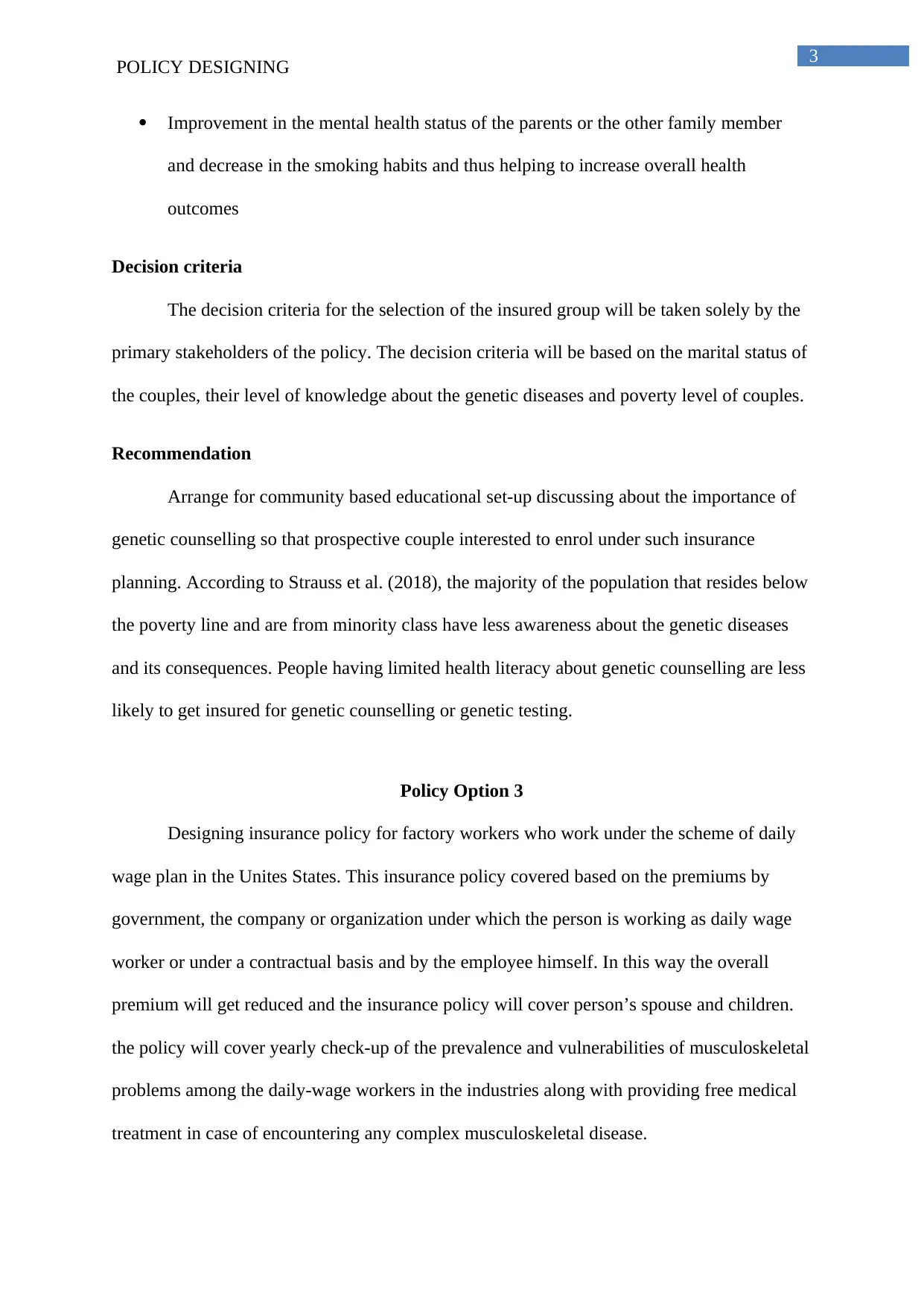
3
POLICY DESIGNING
Improvement in the mental health status of the parents or the other family member
and decrease in the smoking habits and thus helping to increase overall health
outcomes
Decision criteria
The decision criteria for the selection of the insured group will be taken solely by the
primary stakeholders of the policy. The decision criteria will be based on the marital status of
the couples, their level of knowledge about the genetic diseases and poverty level of couples.
Recommendation
Arrange for community based educational set-up discussing about the importance of
genetic counselling so that prospective couple interested to enrol under such insurance
planning. According to Strauss et al. (2018), the majority of the population that resides below
the poverty line and are from minority class have less awareness about the genetic diseases
and its consequences. People having limited health literacy about genetic counselling are less
likely to get insured for genetic counselling or genetic testing.
Policy Option 3
Designing insurance policy for factory workers who work under the scheme of daily
wage plan in the Unites States. This insurance policy covered based on the premiums by
government, the company or organization under which the person is working as daily wage
worker or under a contractual basis and by the employee himself. In this way the overall
premium will get reduced and the insurance policy will cover person’s spouse and children.
the policy will cover yearly check-up of the prevalence and vulnerabilities of musculoskeletal
problems among the daily-wage workers in the industries along with providing free medical
treatment in case of encountering any complex musculoskeletal disease.
POLICY DESIGNING
Improvement in the mental health status of the parents or the other family member
and decrease in the smoking habits and thus helping to increase overall health
outcomes
Decision criteria
The decision criteria for the selection of the insured group will be taken solely by the
primary stakeholders of the policy. The decision criteria will be based on the marital status of
the couples, their level of knowledge about the genetic diseases and poverty level of couples.
Recommendation
Arrange for community based educational set-up discussing about the importance of
genetic counselling so that prospective couple interested to enrol under such insurance
planning. According to Strauss et al. (2018), the majority of the population that resides below
the poverty line and are from minority class have less awareness about the genetic diseases
and its consequences. People having limited health literacy about genetic counselling are less
likely to get insured for genetic counselling or genetic testing.
Policy Option 3
Designing insurance policy for factory workers who work under the scheme of daily
wage plan in the Unites States. This insurance policy covered based on the premiums by
government, the company or organization under which the person is working as daily wage
worker or under a contractual basis and by the employee himself. In this way the overall
premium will get reduced and the insurance policy will cover person’s spouse and children.
the policy will cover yearly check-up of the prevalence and vulnerabilities of musculoskeletal
problems among the daily-wage workers in the industries along with providing free medical
treatment in case of encountering any complex musculoskeletal disease.
Paraphrase This Document
Need a fresh take? Get an instant paraphrase of this document with our AI Paraphraser
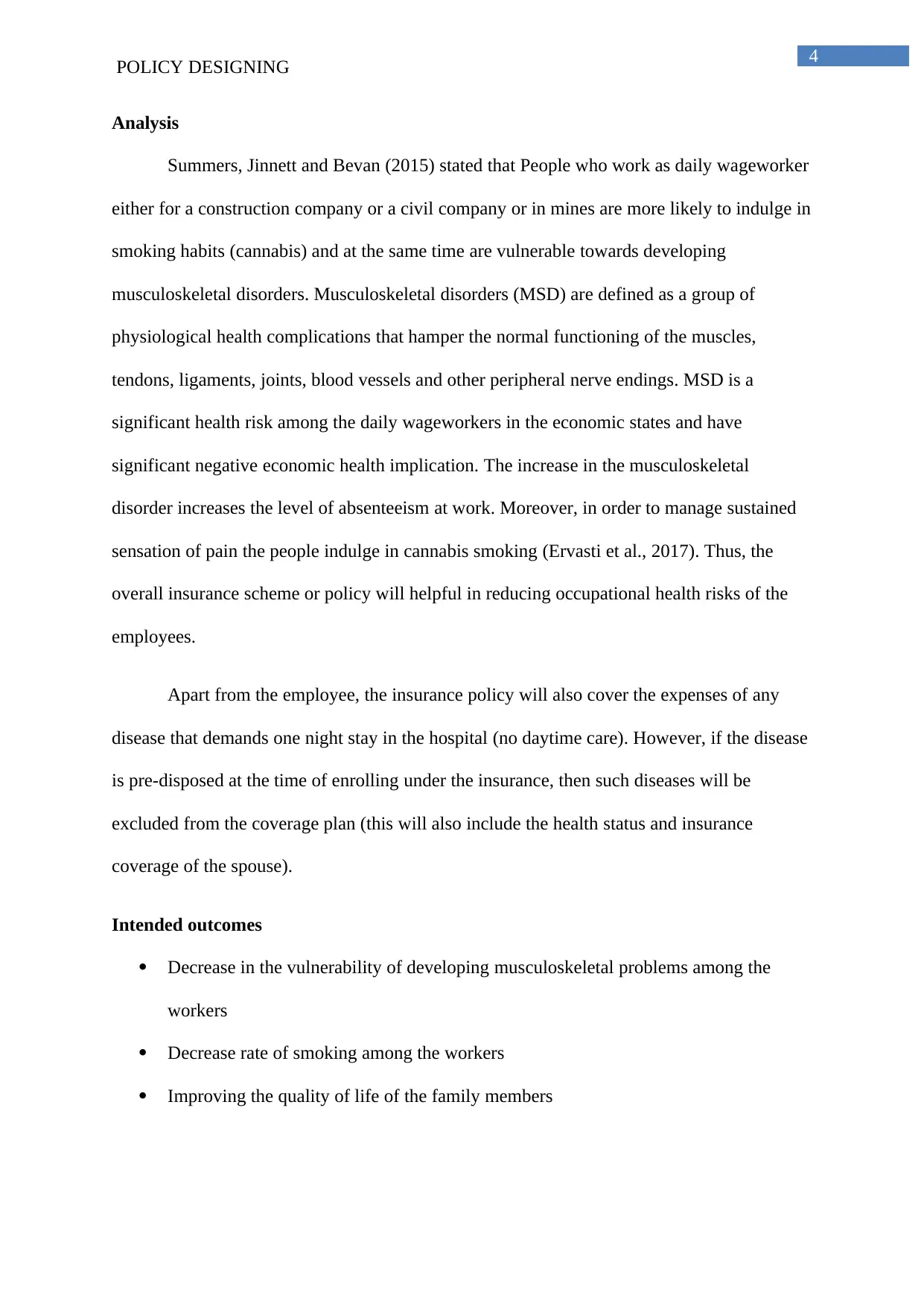
4
POLICY DESIGNING
Analysis
Summers, Jinnett and Bevan (2015) stated that People who work as daily wageworker
either for a construction company or a civil company or in mines are more likely to indulge in
smoking habits (cannabis) and at the same time are vulnerable towards developing
musculoskeletal disorders. Musculoskeletal disorders (MSD) are defined as a group of
physiological health complications that hamper the normal functioning of the muscles,
tendons, ligaments, joints, blood vessels and other peripheral nerve endings. MSD is a
significant health risk among the daily wageworkers in the economic states and have
significant negative economic health implication. The increase in the musculoskeletal
disorder increases the level of absenteeism at work. Moreover, in order to manage sustained
sensation of pain the people indulge in cannabis smoking (Ervasti et al., 2017). Thus, the
overall insurance scheme or policy will helpful in reducing occupational health risks of the
employees.
Apart from the employee, the insurance policy will also cover the expenses of any
disease that demands one night stay in the hospital (no daytime care). However, if the disease
is pre-disposed at the time of enrolling under the insurance, then such diseases will be
excluded from the coverage plan (this will also include the health status and insurance
coverage of the spouse).
Intended outcomes
Decrease in the vulnerability of developing musculoskeletal problems among the
workers
Decrease rate of smoking among the workers
Improving the quality of life of the family members
POLICY DESIGNING
Analysis
Summers, Jinnett and Bevan (2015) stated that People who work as daily wageworker
either for a construction company or a civil company or in mines are more likely to indulge in
smoking habits (cannabis) and at the same time are vulnerable towards developing
musculoskeletal disorders. Musculoskeletal disorders (MSD) are defined as a group of
physiological health complications that hamper the normal functioning of the muscles,
tendons, ligaments, joints, blood vessels and other peripheral nerve endings. MSD is a
significant health risk among the daily wageworkers in the economic states and have
significant negative economic health implication. The increase in the musculoskeletal
disorder increases the level of absenteeism at work. Moreover, in order to manage sustained
sensation of pain the people indulge in cannabis smoking (Ervasti et al., 2017). Thus, the
overall insurance scheme or policy will helpful in reducing occupational health risks of the
employees.
Apart from the employee, the insurance policy will also cover the expenses of any
disease that demands one night stay in the hospital (no daytime care). However, if the disease
is pre-disposed at the time of enrolling under the insurance, then such diseases will be
excluded from the coverage plan (this will also include the health status and insurance
coverage of the spouse).
Intended outcomes
Decrease in the vulnerability of developing musculoskeletal problems among the
workers
Decrease rate of smoking among the workers
Improving the quality of life of the family members
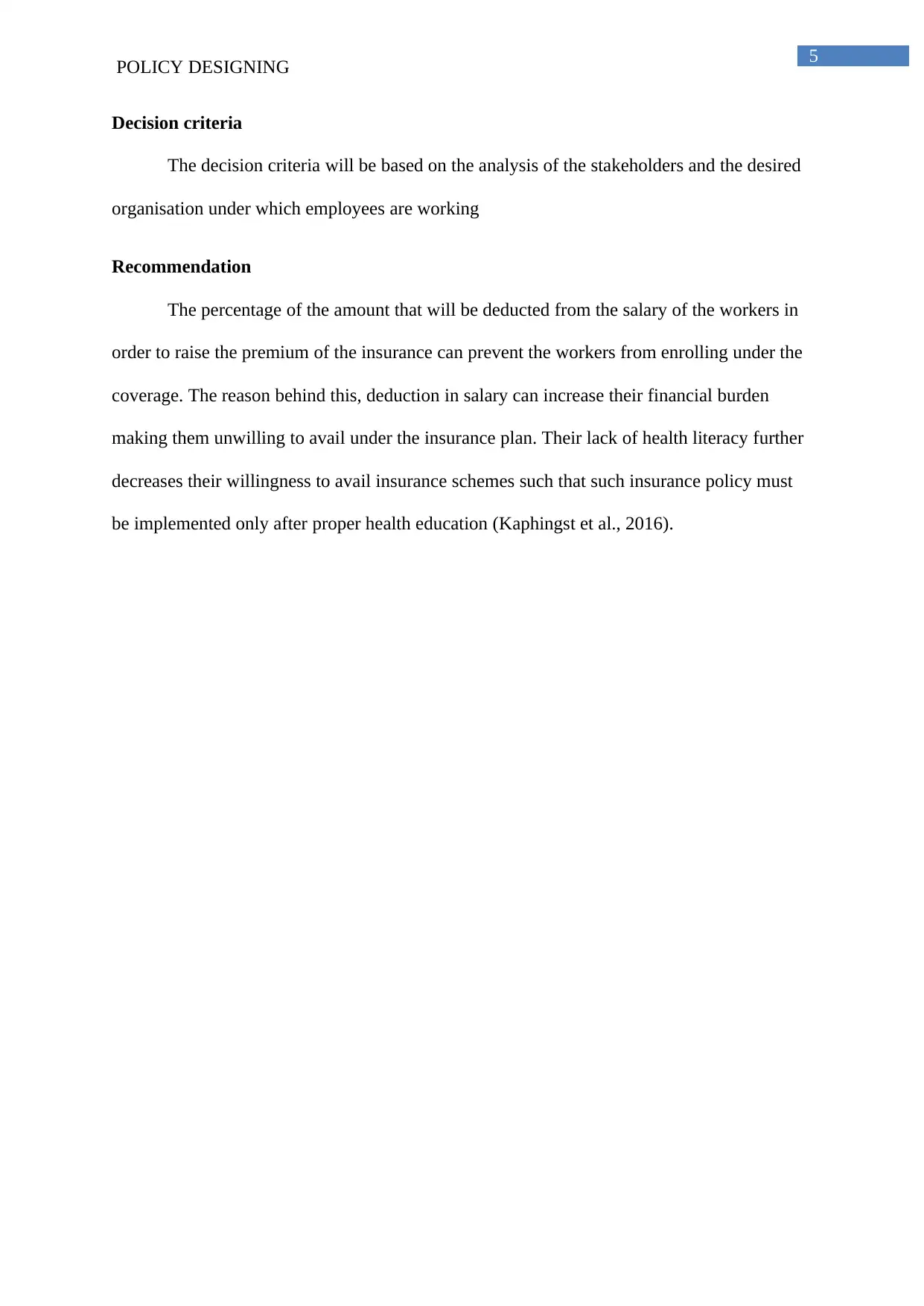
5
POLICY DESIGNING
Decision criteria
The decision criteria will be based on the analysis of the stakeholders and the desired
organisation under which employees are working
Recommendation
The percentage of the amount that will be deducted from the salary of the workers in
order to raise the premium of the insurance can prevent the workers from enrolling under the
coverage. The reason behind this, deduction in salary can increase their financial burden
making them unwilling to avail under the insurance plan. Their lack of health literacy further
decreases their willingness to avail insurance schemes such that such insurance policy must
be implemented only after proper health education (Kaphingst et al., 2016).
POLICY DESIGNING
Decision criteria
The decision criteria will be based on the analysis of the stakeholders and the desired
organisation under which employees are working
Recommendation
The percentage of the amount that will be deducted from the salary of the workers in
order to raise the premium of the insurance can prevent the workers from enrolling under the
coverage. The reason behind this, deduction in salary can increase their financial burden
making them unwilling to avail under the insurance plan. Their lack of health literacy further
decreases their willingness to avail insurance schemes such that such insurance policy must
be implemented only after proper health education (Kaphingst et al., 2016).
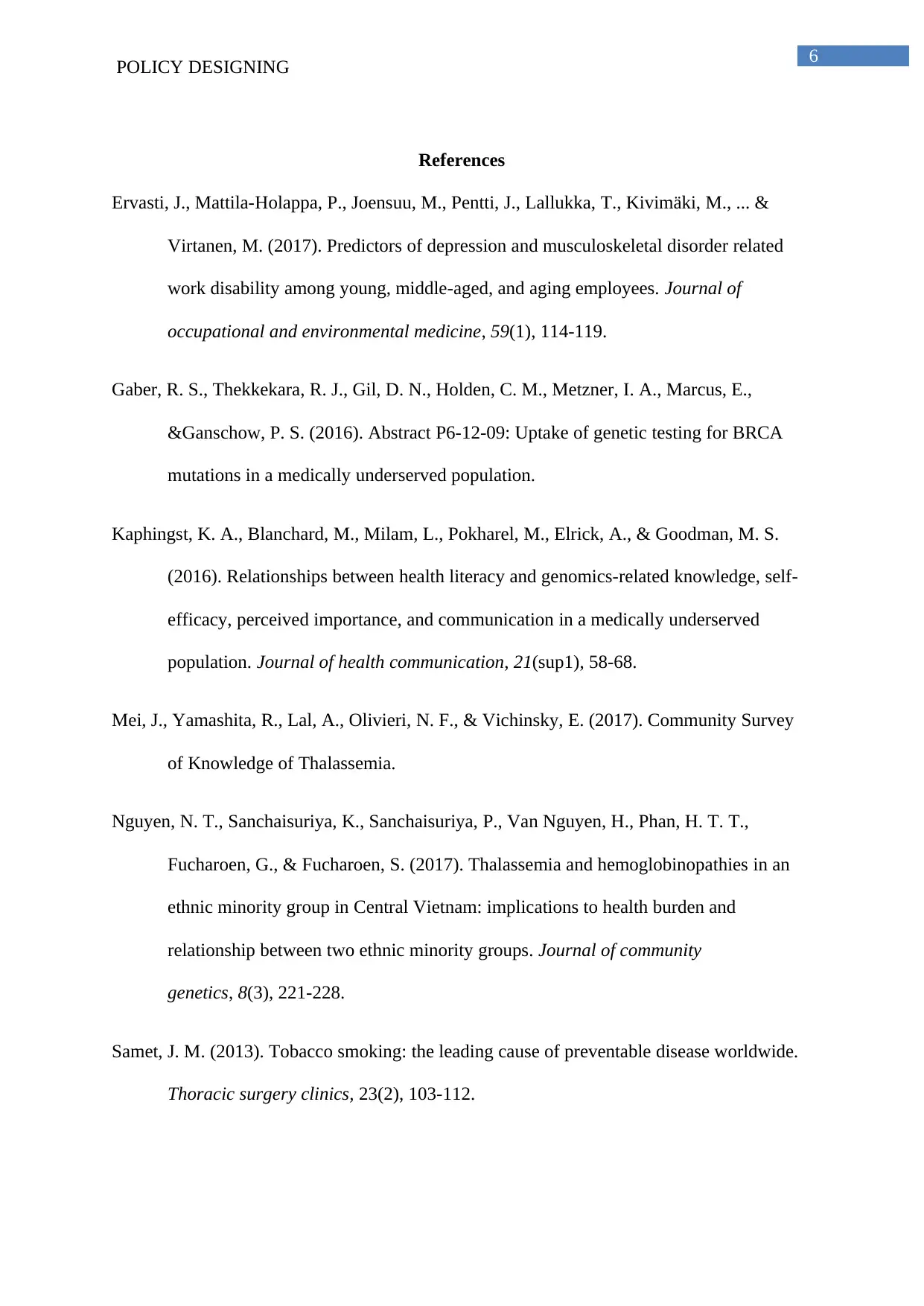
6
POLICY DESIGNING
References
Ervasti, J., Mattila-Holappa, P., Joensuu, M., Pentti, J., Lallukka, T., Kivimäki, M., ... &
Virtanen, M. (2017). Predictors of depression and musculoskeletal disorder related
work disability among young, middle-aged, and aging employees. Journal of
occupational and environmental medicine, 59(1), 114-119.
Gaber, R. S., Thekkekara, R. J., Gil, D. N., Holden, C. M., Metzner, I. A., Marcus, E.,
&Ganschow, P. S. (2016). Abstract P6-12-09: Uptake of genetic testing for BRCA
mutations in a medically underserved population.
Kaphingst, K. A., Blanchard, M., Milam, L., Pokharel, M., Elrick, A., & Goodman, M. S.
(2016). Relationships between health literacy and genomics-related knowledge, self-
efficacy, perceived importance, and communication in a medically underserved
population. Journal of health communication, 21(sup1), 58-68.
Mei, J., Yamashita, R., Lal, A., Olivieri, N. F., & Vichinsky, E. (2017). Community Survey
of Knowledge of Thalassemia.
Nguyen, N. T., Sanchaisuriya, K., Sanchaisuriya, P., Van Nguyen, H., Phan, H. T. T.,
Fucharoen, G., & Fucharoen, S. (2017). Thalassemia and hemoglobinopathies in an
ethnic minority group in Central Vietnam: implications to health burden and
relationship between two ethnic minority groups. Journal of community
genetics, 8(3), 221-228.
Samet, J. M. (2013). Tobacco smoking: the leading cause of preventable disease worldwide.
Thoracic surgery clinics, 23(2), 103-112.
POLICY DESIGNING
References
Ervasti, J., Mattila-Holappa, P., Joensuu, M., Pentti, J., Lallukka, T., Kivimäki, M., ... &
Virtanen, M. (2017). Predictors of depression and musculoskeletal disorder related
work disability among young, middle-aged, and aging employees. Journal of
occupational and environmental medicine, 59(1), 114-119.
Gaber, R. S., Thekkekara, R. J., Gil, D. N., Holden, C. M., Metzner, I. A., Marcus, E.,
&Ganschow, P. S. (2016). Abstract P6-12-09: Uptake of genetic testing for BRCA
mutations in a medically underserved population.
Kaphingst, K. A., Blanchard, M., Milam, L., Pokharel, M., Elrick, A., & Goodman, M. S.
(2016). Relationships between health literacy and genomics-related knowledge, self-
efficacy, perceived importance, and communication in a medically underserved
population. Journal of health communication, 21(sup1), 58-68.
Mei, J., Yamashita, R., Lal, A., Olivieri, N. F., & Vichinsky, E. (2017). Community Survey
of Knowledge of Thalassemia.
Nguyen, N. T., Sanchaisuriya, K., Sanchaisuriya, P., Van Nguyen, H., Phan, H. T. T.,
Fucharoen, G., & Fucharoen, S. (2017). Thalassemia and hemoglobinopathies in an
ethnic minority group in Central Vietnam: implications to health burden and
relationship between two ethnic minority groups. Journal of community
genetics, 8(3), 221-228.
Samet, J. M. (2013). Tobacco smoking: the leading cause of preventable disease worldwide.
Thoracic surgery clinics, 23(2), 103-112.
Secure Best Marks with AI Grader
Need help grading? Try our AI Grader for instant feedback on your assignments.
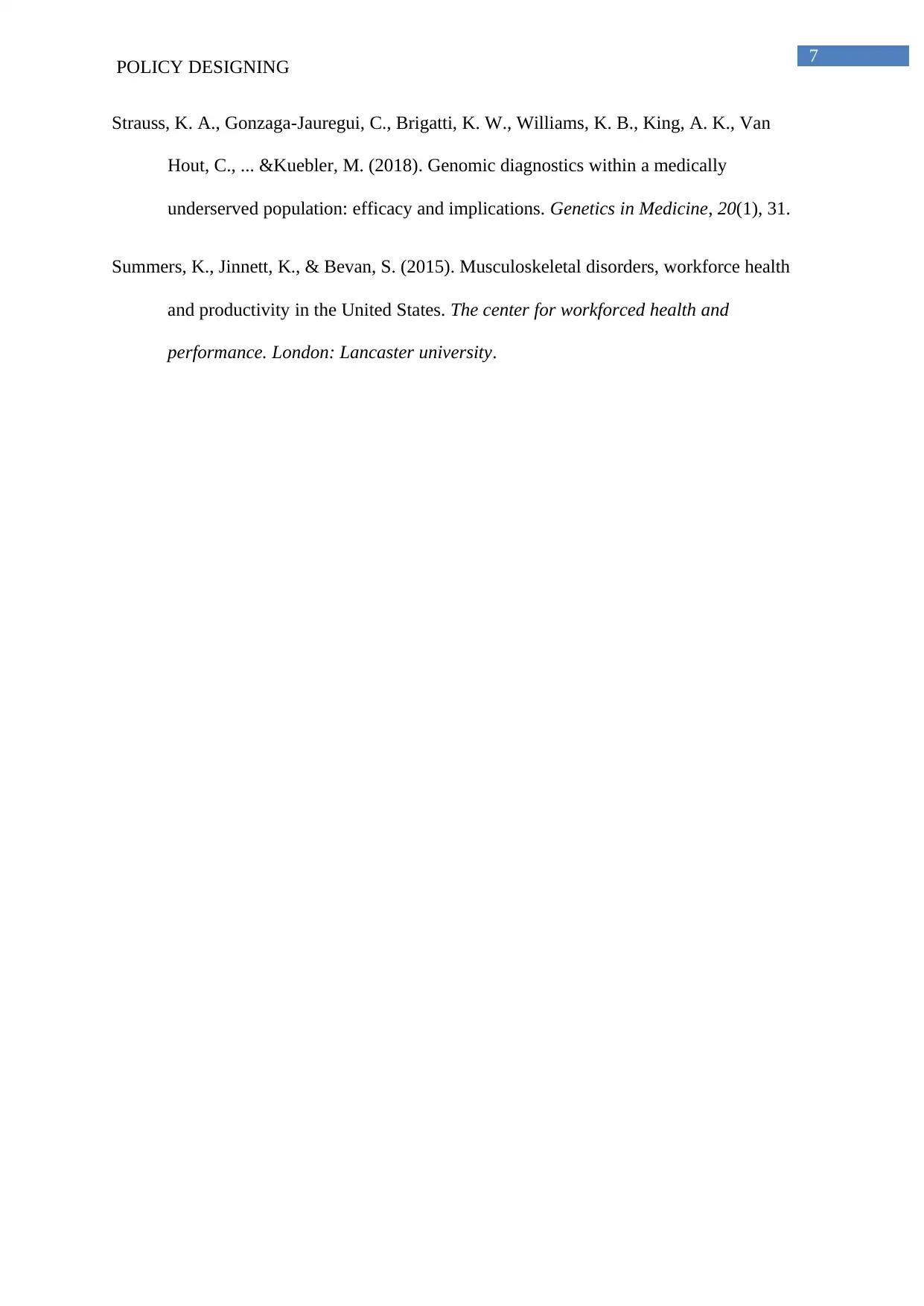
7
POLICY DESIGNING
Strauss, K. A., Gonzaga-Jauregui, C., Brigatti, K. W., Williams, K. B., King, A. K., Van
Hout, C., ... &Kuebler, M. (2018). Genomic diagnostics within a medically
underserved population: efficacy and implications. Genetics in Medicine, 20(1), 31.
Summers, K., Jinnett, K., & Bevan, S. (2015). Musculoskeletal disorders, workforce health
and productivity in the United States. The center for workforced health and
performance. London: Lancaster university.
POLICY DESIGNING
Strauss, K. A., Gonzaga-Jauregui, C., Brigatti, K. W., Williams, K. B., King, A. K., Van
Hout, C., ... &Kuebler, M. (2018). Genomic diagnostics within a medically
underserved population: efficacy and implications. Genetics in Medicine, 20(1), 31.
Summers, K., Jinnett, K., & Bevan, S. (2015). Musculoskeletal disorders, workforce health
and productivity in the United States. The center for workforced health and
performance. London: Lancaster university.
1 out of 8
![[object Object]](/_next/static/media/star-bottom.7253800d.svg)





